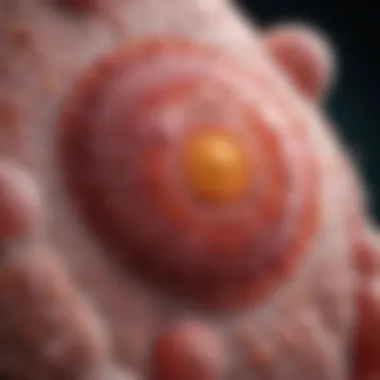Understanding Herpes Simplex Virus Type Two Transmission


Intro
Herpes Simplex Virus Type Two, commonly referred to as HSV-2, is a significant public health concern. Understanding its transmission is crucial for individuals and health professionals alike. The mode of transmission, associated risks, and prevention strategies have become areas of intense focus in recent years. With an emphasis on education and awareness, society can take informed steps to manage this virus more effectively.
Research Context
Background and Rationale
HSV-2 primarily spreads through intimate contact, affecting a considerable portion of the population worldwide. Unlike some infectious diseases that present clear symptoms, a substantial number of individuals infected with HSV-2 remain asymptomatic. This property complicates efforts to control the virus's spread. Understanding how HSV-2 operates within social frameworks and individual behaviors provides valuable insight. This analysis aims to build a foundation for effective interventions and public health strategies.
Literature Review
Numerous studies highlight the prevalence of HSV-2 and its impacts on sexual health. Research indicates that asymptomatic individuals can still transmit the virus, indicating the need for better awareness and education among potentially affected individuals. A comprehensive review of literature indicates multiple transmission modes, including skin-to-skin contact during episodes of viral shedding. These modes are intricately linked to behavioral tendencies, emphasizing the importance of personal responsibility in prevention measures.
The literature also points out the socio-economic implications of HSV-2. Factors such as stigma and misinformation can hinder individuals from seeking treatment or engaging in discussions about prevention, ultimately affecting their health and the health of others.
With a deeper understanding of the transmission dynamics and the socio-behavioral context, we can improve education initiatives, thereby reducing transmission rates in vulnerable populations.
Methodology
Research Design
This article’s exploration is based on qualitative analysis, primarily focusing on existing research studies, medical articles, and public health guidelines concerning HSV-2 transmission. The aim is to synthesize findings to present a clear understanding of how transmission occurs and the risks involved.
Data Collection Methods
Data was collected through various academic and online resources, including peer-reviewed journals, medical guidelines, and reputable public health organizations. This multi-faceted approach ensures that the information is not only comprehensive but also reflects current understanding and recommendations in the field.
Understanding the transmission of HSV-2 is critical for public health education. Without public awareness, efforts to reduce its spread will be severely hampered.
The following sections will delve deeper into specific aspects of HSV-2 transmission, prevention techniques, and the implications for individuals and communities.
Understanding Herpes Simplex Virus Type Two
The understanding of Herpes Simplex Virus Type Two (HSV-2) is essential as it forms the foundation for comprehending its transmission dynamics, associated risks, and management strategies. HSV-2 significantly affects public health due to its prevalence and the complexity of its transmission modes. Recognizing how this virus operates can aid in the development of effective prevention and treatment interventions, but also assist in breaking the stigma associated with sexually transmitted infections (STIs).
Overview of HSV-2
HSV-2 is a virus primarily responsible for genital herpes. It is part of the herpesvirus family that also includes HSV-1, which usually leads to oral herpes. Unlike HSV-1, HSV-2 is predominantly transmitted through sexual contact, leading to outbreaks characterized by painful sores and lesions in the genital region.
This virus is highly contagious. It can be spread even when sores are not visible. The first exposure to HSV-2 often goes unnoticed, as many individuals may not experience significant symptoms. This asymptomatic nature elevates the virus's potential for spread, making education and awareness crucial for effective transmission prevention.
Clinical Manifestations of HSV-2 Infection
The clinical manifestations of HSV-2 infection can vary significantly among affected individuals. Common symptoms include:
- Painful sores and blisters in the genital area, which may recur periodically.
- Itching or discomfort around the genital area.
- Flu-like symptoms such as fever and swollen lymph nodes during initial outbreaks.
Initial outbreaks tend to be the most severe. Symptoms may diminish over time, but the virus remains in the body, often reactivating during times of stress, illness, or when the immune system is compromised. Recognizing and understanding these symptoms is vital for timely diagnosis and management.
Epidemiology of HSV-2
Epidemiologically, HSV-2 is a significant health concern. Globally, an estimated 491 million people aged 18 to 49 are infected with HSV-2, with the highest prevalence in sub-Saharan Africa. The rates tend to fluctuate based on several factors, including:
- Age: Younger individuals, particularly women, show higher infection rates.
- Sex: Women are more likely than men to contract HSV-2 from male partners due to anatomical differences and the nature of sexual contact.
- Geography: The prevalence is notably higher in lower-income countries and regions with limited access to healthcare and education.
Given the infection rates, understanding the epidemiological trends of HSV-2 can guide public health initiatives aimed at reducing its transmission and impact.


Modes of Transmission
Sexual Transmission
Sexual transmission is the most common method through which HSV-2 spreads. The virus is typically found in genital secretions and can be transmitted through vaginal, anal, and oral intercourse. Even when the infected partner shows no visible symptoms, there remains a risk of transmission. This silent spread emphasizes the importance of understanding that HSV-2 can be present without noticeable outbreaks. The use of barriers, such as condoms, significantly lowers the risk of infection, but cannot eliminate it entirely. This is attributed to the potential presence of the virus in areas not covered by condoms. Therefore, engaging in open conversations about sexual health and histories can be particularly advantageous in reducing transmission risks.
Vertical Transmission
Vertical transmission occurs when HSV-2 is passed from a pregnant individual to their child during childbirth. This event can lead to neonatal herpes, a serious condition that may cause severe complications and even fatalities in newborns. The risk increases if the mother contracts the virus close to the time of delivery. This is why screening for HSV-2 during prenatal visits is essential. Healthcare providers often recommend preventive measures if an outbreak is imminent or during the delivery itself, such as cesarean delivery, to safeguard the infant’s health. The understanding of vertical transmission is also critical for informing expectant parents about the risks and necessary precautions.
Transmission through Asymptomatic Shedding
Asymptomatic shedding represents a significant challenge in understanding HSV-2 transmission. Individuals infected with HSV-2 can occasionally expel the virus from their skin even when they do not exhibit any visible sores or symptoms. Studies have shown that this shedding can occur sporadically, projecting a hidden risk for partners unaware of their infected status. This phenomenon underscores the need for regular screenings and education on the potential for silent transmission. Awareness regarding asymptomatic shedding could encourage individuals to communicate more openly about risks associated with HSV-2.
Impact of Oral-Sexual Practices
The increasing popularity of oral sexual practices also plays a role in the transmission of HSV-2. The virus can be transmitted through oral-genital contact, which means it is not limited to traditional penetrative sex. Particularly in partnerships that practice multipartner sexual contact, the risk of HSV-2 can escalate. While the rates of transmission through oral sex are considered lower than genital-genital contact, the risk is still noteworthy. This aspect reinforces the need for comprehensive sexual health education that encompasses all types of sexual practices. By providing information regarding risks associated with oral sex, educators can ensure individuals are better informed when engaging in such activities.
"Understanding the transmission modes of HSV-2 helps in applying preventive measures effectively and enhances communication around sexual health."
In sum, grasping the various modes of transmission of HSV-2 is vital not just for personal health, but it plays a significant role in ongoing public health education efforts. Recognizing how the virus spreads encourages informed decision-making, responsible behaviors, and open discussions around sexual health.
Risk Factors for Transmission
Factors Increasing Susceptibility
Several biological characteristics can increase an individual's susceptibility to HSV-2. Notable factors include:
- Genital mucosal integrity: Any disruption or injury to the genital epithelial barrier can facilitate HSV-2 entry. This includes cuts, abrasions, or inflammation due to other infections.
- Underlying infections: The presence of other sexually transmitted infections (STIs) can enhance susceptibility. For instance, infections like chlamydia or gonorrhea may compromise the local immune response, making it easier for HSV-2 to establish infection.
- Hormonal fluctuations: Hormonal changes, especially in women, can influence the skin and mucosal barrier. Certain stages of the menstrual cycle may increase the likelihood of acquiring HSV-2 due to changes in vaginal environment.
Additional factors like shared sexual practices and overall sexual health play significant roles. Knowing these elements can enhance preventive measures, empowering individuals to make informed decisions about their sexual health.
Role of Immune System
The immune system's strength is fundamental in defending against infections, including HSV-2. Here are key considerations regarding this relationship:
- Immune response: An individual with a robust immune system is better equipped to combat HSV-2 infections. The quality of the immune response can influence the likelihood of virus acquisition and the severity of clinical symptoms.
- Immunocompromised states: Individuals with weakened immune systems, such as those living with HIV/AIDS or taking immunosuppressive medications, face heightened susceptibility to HSV-2. The presence of HSV-2 in these populations may lead to severe outbreaks and complications.
- Vaccination and immunity: While no effective vaccine currently exists specifically for HSV-2, understanding and developing immune response strategies may offer future preventative solutions. Ongoing research aims to explore how modulating immune response can minimize HSV-2 transmission risk.
Psychosocial Factors
Psychosocial elements play an instrumental role in the transmission landscape of HSV-2. Key factors include:
- Sexual behavior: Attitudes towards sex, including the acceptance of casual relationships and multiple partners, significantly impact transmission rates. Education on safe sexual practices is essential in populations with high-risk behaviors.
- Stigma and systemic issues: The stigma surrounding HSV-2 can affect individuals' willingness to seek testing or disclose their status. This can lead to a cycle of silence that perpetuates transmission. Addressing stigma through public health initiatives is necessary for effective prevention.
- Cultural influences: Different cultures may have varying attitudes towards sexuality and STIs. Understanding these cultural contexts can help tailor educational campaigns and health resources appropriately.
"By addressing both biological and psychosocial factors, public health initiatives can more effectively reduce the spread of HSV-2."
Symptoms and Diagnosis
Understanding the symptoms and diagnosis of herpes simplex virus type two (HSV-2) is critical in managing the infection and reducing its transmission. Recognizing symptoms early can lead to more effective treatment and better quality of life for those infected. Furthermore, timely and accurate diagnosis aids in preventing the spread of the virus to others. This section explores typical symptoms and diagnostic approaches, emphasizing their significance in the context of HSV-2.
Typical Symptoms of HSV-2
The symptoms of HSV-2 can vary widely among individuals. Many infected persons may remain asymptomatic, but when symptoms do occur, they can be quite distressing. Common manifestations include:
- Genital lesions: Painful sores or blisters in the genital area are the hallmark of HSV-2 infection. These typically appear as small red bumps that progress to fluid-filled vesicles and then ulcerate.
- Flu-like symptoms: During the initial outbreak, individuals may experience systemic symptoms such as fever, body aches, and swollen lymph nodes.
- Itching and discomfort: The affected areas often feel itchy, leading to significant discomfort for the patient.
- Recurrent outbreaks: Many people experience recurrent episodes of sores, though subsequent outbreaks tend to be less severe and shorter in duration.
It is vital to note that symptoms may not always coincide with active transmission. Asymptomatic shedding often occurs, enabling the virus to spread even when no lesions are observable.


"The asymptomatic nature of HSV-2 makes awareness and education paramount in preventing transmission."
Diagnostic Approaches
Diagnosing HSV-2 involves several methods. Accurate diagnosis is essential for effective management and to rule out other conditions. Common diagnostic methods include:
- Clinical examination: Physicians typically diagnose HSV-2 based on a physical examination of the symptoms. The characteristic appearance of genital lesions often provides immediate clues.
- Polymerase chain reaction (PCR) test: This highly sensitive molecular test detects HSV DNA in fluid from lesions or other body samples, making it a definitive method for diagnosis.
- Serological testing: Blood tests can identify antibodies against HSV-2, indicating past or current infection. This is particularly useful for asymptomatic individuals who may not have visible symptoms.
- Viral culture: While less commonly used now due to PCR's accuracy, a viral culture can isolate the virus from a lesion sample, confirming HSV-2.
Awareness of these diagnostic approaches allows individuals to seek appropriate medical advice, leading to better management of their condition and reducing the risk of transmission.
Prevention Strategies
Safe Sex Practices
Safe sex practices are essential in limiting the spread of HSV-2 among sexually active individuals. These include the consistent and correct use of condoms. Although condoms cannot provide complete protection against HSV-2, they reduce the risk of transmission significantly.
Additionally, engaging in mutually monogamous relationships can decrease exposure. Communication between partners about sexual health and history is vital. Avoiding sexual activity during outbreaks is also recommended. Using barrier methods like dental dams during oral intercourse can further minimize risks.
Some of the key points about safe sex include:
- Always use latex or polyurethane condoms, even when asymptomatic.
- Have open discussions about HSV-2 with partners before engaging in sexual activity.
- Avoid sexual contact during outbreaks and when symptoms are present.
"Knowledge and precaution are the first line of defense against HSV-2 transmission."
Education and Awareness
Education and awareness are fundamental components of prevention. Knowledge about HSV-2’s transmission routes and risk factors allows individuals to make informed choices. Educational programs should target not only high-risk populations but also the general public to foster understanding about the virus.
Access to credible and comprehensive resources is vital. Schools, healthcare providers, and community organizations can play significant roles in disseminating this knowledge. Increased awareness can lead to reduced stigma, encouraging those affected to seek testing and treatment.
Some effective educational strategies might include:
- Workshops and seminars on sexual health, focusing on HSV-2.
- Distribution of informational brochures in clinics and schools.
- Utilization of online platforms for broader reach, such as social media or educational websites.
Vaccination Research
Vaccination for HSV-2 is an area of active research. Although no vaccine is currently available, ongoing studies aim to develop an effective immunization strategy. An effective vaccine could dramatically reduce the burden of the virus by preventing initial infections and potentially curbing outbreaks.
Research efforts focus on different types of vaccine strategies, such as:
- Subunit vaccines: which introduce immune response without causing infection.
- Live-attenuated vaccines: which involve weakened versions of the virus.
- DNA vaccines: designed to elicit strong immune responses through genetic material.
The development of a successful vaccine holds the potential to change the landscape of HSV-2 prevention, making it a hot topic in public health research. Individuals should stay informed about these developments, as they may represent a future solution to this prevalent health issue.
Treatment and Management
Treatment and management of Herpes Simplex Virus Type Two (HSV-2) are crucial for those infected. Effective strategies can mitigate symptoms, reduce recurrence, and lower transmission risks. Understanding these elements helps in managing the impact of HSV-2 on individuals and their relationships.
Antiviral Medications
Antiviral medications are the primary tool in managing HSV-2 infection. These drugs help to limit the severity and duration of outbreaks. Common antiviral medications include Acyclovir, Valacyclovir, and Famciclovir. Each of these has been proven effective in reducing symptoms. They can also decrease the frequency of outbreaks, allowing individuals to maintain a better quality of life.
- Acyclovir: Often used in both oral and topical forms, this medication can effectively reduce the duration of outbreaks when taken at the onset of symptoms.
- Valacyclovir: This is a prodrug of Acyclovir, offering more convenient dosing schedules. It helps in managing both episodic and suppressive therapy for HSV-2.
- Famciclovir: This also acts as a prodrug, with similar benefits to Valacyclovir. It is particularly useful for those who experience frequent outbreaks.
These medications do not cure HSV-2 but can manage symptoms. In many cases, early intervention leads to better outcomes for those affected, reducing both physical discomfort and emotional distress.
Long-Term Management Strategies


Long-term management of HSV-2 requires a comprehensive approach. Beyond antiviral treatments, several strategies can help manage symptoms and reduce transmission. Here are some important considerations for effective long-term management:
- Regular Follow-Ups: Regular check-ups with a healthcare provider can help adjust treatment plans according to the person's evolving situation.
- Education on Symptom Awareness: Being aware of the early signs and symptoms can trigger timely interventions. This reduces the duration of outbreaks and helps in managing recurrent infections.
- Lifestyle Modifications: Stress management techniques, adequate sleep, and a balanced diet play a vital role in maintaining overall health. Lifestyle changes can influence the immune response, potentially decreasing the frequency of outbreaks.
- Safe Practices: Discussions about safe sex practices remain crucial. This includes honest conversations with partners about HSV-2 status, consistent condom use, and considering suppressive therapy to lower transmission risks.
Effective management of HSV-2 extends beyond medications; it encompasses education, lifestyle changes, and communication.
Through a multifaceted approach, individuals can significantly improve their quality of life while minimizing risks associated with herpes transmission.
Societal Implications
Understanding the societal implications of herpes simplex virus type two (HSV-2) is of critical importance. This knowledge extends beyond mere medical data to encompass social behaviors, personal relationships, and public health strategies. The ramifications of HSV-2 transmission reach far and influence societal dynamics, awareness, and even healthcare policies. Recognition of these aspects can potentially shift the stigma surrounding the virus and improve overall health outcomes.
Stigma Associated with HSV-2
The stigma attached to HSV-2 is profound and pervasive. Individuals diagnosed with this virus often experience shame and isolation due to societal misconceptions. This stigma is fueled by a lack of education surrounding the virus and its transmission. Many associate HSV-2 solely with promiscuity or poor hygiene, which oversimplifies the reality of how the virus spreads.
Research indicates that stigma can significantly impact mental health. People may avoid seeking medical help or disclosing their status to partners, fearing judgment or rejection. This hinders effective treatment and support systems. There needs to be a concerted effort to reshape the narrative around HSV-2. Openness, education, and dialogue are essential in diminishing the stigma:
- Promoting awareness about HSV-2 through educational initiatives can significantly alter public perception.
- Encouraging conversations in community settings can foster understanding, compassion, and support for those affected.
"Understanding and addressing stigma can empower individuals to seek the help they need without fear of social repercussions."
Impact on Relationships
HSV-2 carries implications not just for individuals but also for their relationships. When one partner is diagnosed, it raises concerns about sexual health and emotional trust. Dialogue about HSV-2 is often limited, which can lead to misunderstandings and tension in intimate relationships.
Studies suggest that partners might experience a range of responses following a diagnosis:
- Fear of transmission often leads to anxiety around physical intimacy.
- Reassurance and education about safe practices are crucial to preserving trust.
- Couples may benefit from counseling, where both partners can discuss their feelings constructively.
The ability to navigate these challenges depends on communication and informed consent. By providing clear information about HSV-2, couples can develop strategies to maintain healthy relationships.
Public Health Strategies
Public health strategies play a vital role in combating the transmission of HSV-2. Several programs can enhance awareness and reduce stigma, which contributes to a healthier population. Effective public health approaches include:
- Education campaigns aimed at disseminating accurate information about HSV-2. These should focus on the realities of transmission and the importance of communication among partners.
- Accessible testing solutions. Making testing more available allows individuals to understand their health status and seek treatment as needed.
- Promotion of safe practices, including condom use, can reduce the risk of transmission.
- Community support networks can offer assistance and information, enhancing the well-being of those affected.
Understanding the societal implications of HSV-2 is essential. By addressing stigma, supporting healthy relationships, and promoting effective public health strategies, we create a better environment for those affected by the virus.
Future Directions in Research
Research into herpes simplex virus type two (HSV-2) is vital for better understanding and managing the disease. Continued exploration in this area can lead to significant advancements in treatment, prevention, and education. Emerging scientific inquiries can also address the broader societal impacts of the virus. Novel findings may enhance our tools in combating not only the clinical aspects of HSV-2 but also the psychosocial dimensions surrounding it.
Emerging Therapeutic Approaches
A focus on emerging therapeutic approaches can greatly influence how HSV-2 is managed in clinical settings. Recent studies explore new antiviral agents that target different stages of the HSV-2 lifecycle. For instance, compounds like FV-100 and pritelivir show promise in reducing viral replication more effectively than traditional antivirals.
Additionally, research into host-targeted therapies offers potential new pathways. These aim to enhance the immune response to the virus. Agents that modulate the immune system could complement existing antiviral treatments. The synergy between antivirals and immune modulators might future-proof the management of HSV-2, leading to more sustainable treatment options.
Education around these new approaches remains critical. As new therapies emerge, healthcare professionals must disseminate this knowledge. Improved therapeutic options will only be effective if integrated into public health frameworks.
Potential for a Vaccine
The potential for a vaccine against HSV-2 represents one of the most exciting frontiers in current research. While vaccines exist for other viruses, the development of an HSV-2 vaccine has been challenging. However, advancements in immunology and vaccine technology provide hope for future breakthroughs.
Promising candidates, such as the gD2 and gE vaccines, have shown positive results in early trials. These vaccines aim to stimulate the immune system to recognize and combat the virus effectively. If successful, they could significantly reduce HSV-2 incidence in various populations.
The quest for an HSV-2 vaccine also highlights the importance of collaborative research. Academic institutions, pharmaceutical companies, and public health organizations must work together. Sharing data and insights can accelerate the development of effective vaccines.
"The development of an HSV-2 vaccine could fundamentally change the landscape of herpes simplex virus infections and reduce stigma associated with them."
Continued funding and research support for clinical trials are essential. The eventual rollout of a vaccine can transform preventive strategies for HSV-2. It can protect at-risk populations and improve global health outcomes.



